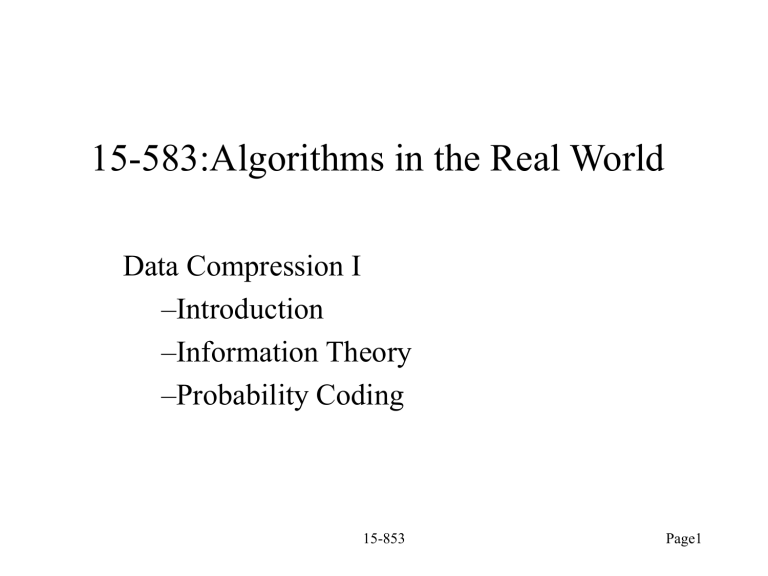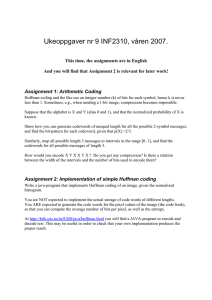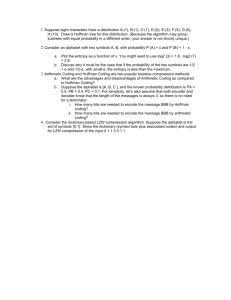Data Compression Algorithms: Intro, Theory, Coding
advertisement

15-583:Algorithms in the Real World
Data Compression I
–Introduction
–Information Theory
–Probability Coding
15-853
Page1
Compression in the Real World
Communication
• Fax: ITU-T Group 3 (run-length + Huffman)
• Modems: V.42bis protocol (LZW) MNP5 (RL + Huffman)
• Virtual Connections
15-853
Page2
Multimedia
• Images: gif (LZW), jbig (context), jpeg-ls (residual),
jpeg (transform+RL+arithmetic)
• TV: HDTV (mpeg-4)
• Sound: mp3
15-853
Page3
Compression Outline
Introduction: Lossy vs. Lossless, Benchmarks, …
Information Theory: Entropy, etc.
Probability Coding: Huffman + Arithmetic Coding
Lempel-Ziv Algorithms: LZ77, gzip, compress, ...
Lossy algorithms for images: JPEG, fractals, ...
Lossy algorithms for sound?: MP3, ...
15-853
Page4
Encoding/Decoding
Will use “message” in generic sense to mean the data
to be compressed
Input
Message
Encoder Compressed Decoder
Message
Output
Message
The encoder and decoder need to understand
common compressed format.
15-853
Page5
Lossless vs. Lossy
Lossless: Input message = Output message
Lossy: Input message Output message
Lossy does not necessarily mean loss of quality. In
fact the output could be “better” than the input.
– Drop random noise in images (dust on lens)
– Drop background in music
– Fix spelling errors in text. Put into better form.
Writing is the art of lossy text compression.
15-853
Page6
How much can we compress?
For lossless compression, assuming all input
messages are valid, if even one string is
compressed, some other must expand.
15-853
Page7
Model vs. Coder
To compress we need a bias on the probability of
messages. The model determines this bias
Encoder
Messages
Model
Probs.
Coder
Bits
Example models:
– Simple: Character counts, repeated strings
– Complex: Models of a human face
15-853
Page8
Information Theory
An interface between modeling and coding
• Entropy
– A measure of information content
• Conditional Entropy
– Information content based on a context
• Entropy of the English Language
– How much information does each character in
“typical” English text contain?
15-853
Page9
Entropy (Shannon 1948)
For a set of messages S with probability p(s), s S,
the self information of s is:
1
i ( s) log
log p( s)
p( s)
Measured in bits if the log is base 2.
The lower the probability, the higher the information
Entropy is the weighted average of self information.
1
H ( S ) p( s) log
p( s)
sS
15-853
Page10
Entropy Example
p( S ) {.25,.25,.25,.125,.125}
H ( S ) 3.25 log 4 2.125 log 8 2.25
p( S ) {.5,.125,.125,.125,.125}
H ( S ) .5 log 2 4.125 log 8 2
p( S ) {.75,.0625,.0625,.0625,.0625}
H ( S ) .75 log(4 3) 4.0625 log 16 13
.
15-853
Page11
Coding
How do we use the probabilities to code messages?
• Prefix codes and relationship to Entropy
• Huffman codes
• Arithmetic codes
• Implicit probability codes
15-853
Page12
Assumptions
Communication (or file) broken up into pieces called
messages.
Adjacent messages might be of a different types and
come from a different probability distributions
We will consider two types of coding:
• Discrete: each message is a fixed set of bits
– Huffman coding, Shannon-Fano coding
• Blended: bits can be “shared” among messages
– Arithmetic coding
15-853
Page13
Uniquely Decodable Codes
A variable length code assigns a bit string (codeword)
of variable length to every message value
e.g. a = 1, b = 01, c = 101, d = 011
What if you get the sequence of bits
1011 ?
Is it aba, ca, or, ad?
A uniquely decodable code is a variable length code
in which bit strings can always be uniquely
decomposed into its codewords.
15-853
Page14
Prefix Codes
A prefix code is a variable length code in which no
codeword is a prefix of another word
e.g a = 0, b = 110, c = 111, d = 10
Can be viewed as a binary tree with message values
at the leaves and 0 or 1s on the edges.
0
1
0 1
a
0
1
b
c
15-853
d
Page15
Some Prefix Codes for Integers
n
1
2
3
4
5
6
Binary
..001
..010
..011
..100
..101
..110
Unary
0
10
110
1110
11110
111110
Split
1|
10|0
10|1
110|00
110|01
110|10
Many other fixed prefix codes:
Golomb, phased-binary, subexponential, ...
15-853
Page16
Average Length
For a code C with associated probabilities p(c) the
average length is defined as
la (C) p(c)l (c)
cC
We say that a prefix code C is optimal if for all
prefix codes C’, la(C) la(C’)
15-853
Page17
Relationship to Entropy
Theorem (lower bound): For any probability
distribution p(S) with associated uniquely
decodable code C,
H ( S ) la (C)
Theorem (upper bound): For any probability
distribution p(S) with associated optimal prefix
code C,
la (C) H ( S ) 1
15-853
Page18
Kraft McMillan Inequality
Theorem (Kraft-McMillan): For any uniquely
decodable code C,
2
l ( c)
1
cC
Also, for any set of lengths L such that
l
2
1
l L
there is a prefix code C such that
l (ci ) li (i 1,...,| L|)
15-853
Page19
Proof of the Upper Bound (Part 1)
Assign to each message a length l ( s) log 1 p( s)
We then have
log 1/ p ( s )
l ( s)
2
sS
2
2
p ( s)
sS
log 1/ p ( s )
sS
sS
1
So by the Kraft-McMillan ineq. there is a prefix code
with lengths l(s).
15-853
Page20
Proof of the Upper Bound (Part 2)
Now we can calculate the average length given l(s)
p ( s) l ( s)
p( s) log1 / p( s)
p( s) (1 log(1 / p( s)))
1 p( s) log(1 / p( s))
la ( S )
sS
sS
sS
sS
1 H (S )
And we are done.
15-853
Page21
Another property of optimal codes
Theorem: If C is an optimal prefix code for the
probabilities {p1, …, pn} then pi < pj
implies l(ci) l(cj)
Proof: (by contradiction)
Assume l(ci) > l(cj). Consider switching codes ci
and cj. If la is the average length of the original
code, the length of the new code is
la' la p j (l (ci ) l (c j )) pi (l (c j ) l (ci ))
la ( p j pi )(l (ci ) l (c j ))
la
This is a contradiction since la is not optimal
15-853
Page22
Huffman Codes
Invented by Huffman as a class assignment in 1950.
Used in many, if not most compression algorithms
• gzip, bzip, jpeg (as option), fax compression,…
Properties:
– Generates optimal prefix codes
– Cheap to generate codes
– Cheap to encode and decode
– la=H if probabilities are powers of 2
15-853
Page23
Huffman Codes
Huffman Algorithm
• Start with a forest of trees each consisting of a
single vertex corresponding to a message s and
with weight p(s)
• Repeat:
– Select two trees with minimum weight roots p1
and p2
– Join into single tree by adding root with weight
p1 + p 2
15-853
Page24
Example
p(a) = .1, p(b) = .2, p(c ) = .2, p(d) = .5
a(.1)
(.3)
b(.2)
c(.2)
d(.5)
(.5)
(1.0)
1
0
(.5) d(.5)
a(.1) b(.2)
(.3)
c(.2)
1
0
Step 1
(.3)
c(.2)
a(.1) b(.2)
0 1
Step 2
a(.1) b(.2)
Step 3
a=000, b=001, c=01, d=1
15-853
Page25
Encoding and Decoding
Encoding: Start at leaf of Huffman tree and follow
path to the root. Reverse order of bits and send.
Decoding: Start at root of Huffman tree and take
branch for each bit received. When at leaf can
output message and return to root.
There are even faster methods that
can process 8 or 32 bits at a time
15-853
(1.0)
1
0
(.5) d(.5)
1
0
(.3)
c(.2)
0
1
a(.1) b(.2)
Page26
Huffman codes are optimal
Theorem: The Huffman algorithm generates an
optimal prefix code.
15-853
Page27

